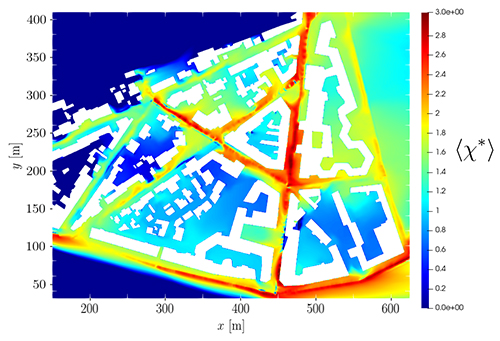Urban road traffic is a significant source of pollutant emissions that impacts air quality. Being able to predict the dispersion of these emissions is of major importance for evaluating real exposure and planning traffic flows.
To this end, a PhD research project1 proposed a modeling chain making it possible to simulate highly turbulent flows on a local urban scale and obtain two-dimensional spatial maps of pollutant concentration (figure 1) [1].

Drawing up these maps involves different uncertain variables (i.e., variables that are either unknown or little known in advance): weather-related variables (wind direction θ and strength "U" _"∞" ) and traffic-related variables (traffic volume q, speed limit vmax and proportion of diesel and gasoline vehicles β). Some have a greater impact than others on the outputs predicted by the model and these are identified using sensitivity methods, one of the themes tackled within the CIROQUO consortium2.
Concerning these methods, the traditional approach consists in calculating a usual sensitivity index (such as Sobol indices3) on a discretized space to obtain sensitivity maps. Within the framework of another CIROQUO/IFPEN thesis4, a new family of sensitivity indices adapted to model outputs, which are not scalars but sets, was proposed [2] and implemented for this application [3]. Instead of producing sensitivity maps, this new approach characterizes the influence of different input parameters on a random set. Here, the set considered is three-dimensional, with spatial coordinates on the one hand (x,y) and the pollutant concentration level on the other, as calculated from various values of uncertain variables. Its performance was compared with methods taken from the literature: Sobol indices (following adaptation to sets) and so-called universal indices that can be applied to all types of variables.
The results of this comparison are presented in figure 2 and show, firstly, that the different approaches deliver similar results in terms of ranking the influence of input variables. However, the new, more sophisticated method also makes it possible to determine whether or not variables are negligible in nature via a statistical test (screening). The result is a potential reduction in the number of variables to be studied. Moreover, the confidence intervals obtained on index predictions are globally lower than with the other approaches [3].

In conclusion, the new approach proposed makes it possible to determine whether or not a variable is negligible, and then to rank the remaining variables by degree of importance. Finally, this new method potentially opens up interesting avenues for other applications requiring knowledge of the influence of uncertain variables during robust optimization5 [2].
1- Thesis by Mathis Pasquier, Quantification d’incertitudes pour la dispersion turbulente de polluants liés au trafic routier à l’échelle micro-urbaine (Uncertainty quantification for the turbulent dispersal of road traffic pollutants on a local urban scale), Aix Marseille University, defended on 21 December 2023.
2- Consortium Industrie et Recherche pour l’Optimisation et la Quantification d’incertitude pour les données onéreuses (Industrial Research Consortium dedicated to the Optimization and Quantification of Uncertainties for Expensive Data): https://ciroquo.ec-lyon.fr/
3- Sensitivity index of an output variable with respect to an input variable (based on variance decomposition).
4- Thesis by Noé Fellmann, Analyse de sensibilité des problèmes d'optimisation sous incertitudes (Sensitivity analysis of optimization problems under uncertainties), Ecole Centrale Lyon (ongoing).
5- i.e., optimization for which all admissible solutions are defined by constraints dependent on uncertain variables.
References:
-
Mathis Pasquier, Stéphane Jay, Jérôme Jacob, Pierre Sagaut. A Lattice-Boltzmann-Based Modelling Chain for Traffic-Related Atmospheric Pollutant Dispersion at the Local Urban Scale. Building and Environment, 2023, 242, pp.110562
>> 10.1016/j.buildenv.2023.110562
-
Noé Fellmann, Christophette Blanchet-Scalliet, Céline Helbert, Adrien Spagnol, Delphine Sinoquet. Kernel-based sensitivity analysis for (excursion) sets, Technometrics, 2024, 1–13
>> 10.1080/00401706.2024.2336537
-
Noé Fellmann, Mathis Pasquier, Céline Helbert, Adrien Spagnol, Delphine Sinoquet, Christophette Blanchet-Scalliet, Sensitivity analysis for sets: application to pollutant concentration maps. 2023
>> hal-04312097
Scientific contacts: adrien.spagnol@ifpen.fr and Delphine Sinoquet
You may also be interested in
Road transport emissions: integrated research for air quality!
According to the WHO, 7 million premature deaths worldwide each year are linked to poor air quality, a problem to which road transport makes a significant contribution. Thanks to regulatory and technological developments, as well as the renewal of the vehicle fleet, emissions from this sector have certainly been falling in recent years. However, it remains a major contributor to the deterioration of air quality...
SC7 - Variable speed limits: for more eco-friendly urban traffic management
Driven by environmental and energy frugality challenges, there is growing interest in vehicle fuel efficiency and a reduction in the impact of mobility. While the promotion of alternative transport modes to cars remains the principal lever for change, much can still be done in terms of road traffic management. An IFPEN team worked on this subject as part of a thesis in collaboration with Gipsa-lab...









